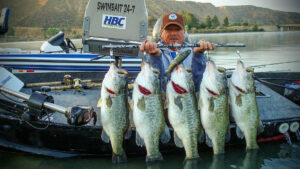So most anglers that follow bass fishing are aware of the big swimbait fishing popular on those trout stocked waters out West. But many are not aware of a segment of the big bait fishing that has gained popularity dramatically in the last 5 years called glide bait fishing. A glide bait is nothing more than a single jointed hard swimbait that swims with a wider S-motion in the water.
What gives the bait category its name however is the ability to pop or pull the rod and cause the bait to careen and glide off to one side, often triggering a following bass to strike. We’ve only been playing with glide baits for the last year or two and figured we should reach out to someone well known in that arena to maybe educate us all on how we can add it to our fishing.
So I called Butch Brown, noted big bass and swimbait expert, known by many as the godfather of swimbait fishing. Brown has more than 1,600 bass weighing more than 10 pounds to his credit, a large majority of those being documented on video. I have followed Butch’s exploits for nearly a decade now, and what he has done out of a small boat with a big rod and big swimbait is awe inspiring.
Here are a few things to know about glide baits and how to make them work on your fishery:
- Butch Brown’s history with glide baits
- About the baits
- Choosing adequate tackle
- Where to fish them
- Focus on your retrieves
- Fight ‘em fast
- The difference
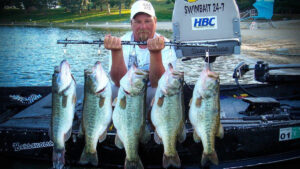
Brown’s history on glide baits
Brown started back in the day slinging big Huddleston Deluxe trout swimbaits. In fact, it was Ken Huddleston that suggested to Brown that he document his catches including everything: the cast, bait landing, retrieve, hookset, fight, net landing and lift. There still seem to be quite a few naysayers in the sport of big bass fishing. But Brown has done a good job documenting his catches.
He is a bit of a hoarder when it comes to big swimbaits. The first run of Huddleston swimbaits saw 200 baits hit the market. Brown bought 100 of them. He wanted ones to fish, ones to play with rigging, to cut open and modify. But mostly, he wanted to have the majority of the baits so when he got the bite perfected he’d have the golden goose so to speak.
In 2009, Brown began taking a young Japanese angler fishing with him. He had met him at the ramp of his favorite body of water, Castaic Lake in Southern California. As a token of his appreciation, the young angler gave Brown a Deps 175 Slide Swimmer as a present. The Slide Swimmer wasn’t yet available to anyone in the US and only available to Deps Members.
The bait was smaller than Brown liked to throw, but the first time he got it wet, he fell in love with its action. His new fishing buddy said they were planning to make a larger 250 version. He asked Brown if he wanted to buy some on his behalf.
“I didn’t know if they would run right, so I told him to just get me 10 of them to start,” Brown said. “I actually got them and didn’t take them out for a month or so because I was still fishing my Hudds. I finally got one out and after playing with hooks and line I got a setup I was happy with. The first outing with the bait in March of 2010, I boated four bass weighing more than 10 pounds. I knew that day I had the golden goose.”
Brown went home and put an eBay alert on his phone for Slide Swimmers. Because they weren’t readily available stateside at the time, about the only place you could find them was on eBay. The first two years, Brown bought EVERY Slide Swimmer 250 that he saw. He literally cornered the market.
The practice of “bait blocking” is fairly common among tournament anglers. When a hot bite gets going on a specific color or lure, the anglers will clear the pegs at local stores to bar competitors from having them.
I remember in 2004, George Cochran won a BASS Tour event on Guntersville and the next event was on Table Rock Lake. Word was out that the Storm Wiggle Wart was the hot bite. There was a line to get in the tackle shop that had the largest stock of them. George pushed a cart up to the Wiggle Wart rack and proceeded to clear every peg of them. After all, he had $100,000 in his pocket from the previous tournament.
But we’re talking about swimbaits that sell between $70-$300 a piece on eBay.
Brown has had so much success on the Deps Slide Swimmer glide baits, that he now works with them in an official capacity helping them design colors and improve the original designs.
“I was so afraid when they put my name on it, they might change something,” Brown said. “The bait was perfect, and I didn’t want them to mess it up. I do tweak them a lot with different hooks and removing some of their internal weights or changing the eyes on them. But the baits are awesome right out of the box. I just like to experiment and get them to do different things because I fish swimbaits 24/7.”
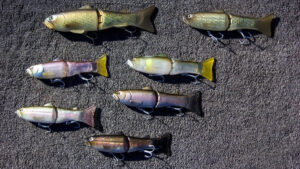
The Slide Swimmer
Brown settled on the Slide Swimmer early and never saw any reason to experiment with other baits. He instead sought to perfect his technique with that bait. Learning the nuances of retrieve speed, weight and cadence.
The Deps Slide Swimmer is unique in many ways from other glide baits. It has a hard body that actually features a softer skin laid over the top of it. The skin can be pulled back to access the weight system of the bait to change its sink rate. It also employs a tungsten ball on a spring that vibrates in the throat of the bait. It gives the bait subtle pressure waves that a predator can detect when the bait comes to rest or is slowly sinking on a pause.
It has tacky sharp silver hooks. Some anglers swap the hooks out for more natural bronze colored hooks.
The bait has a great side to side action on a slow reel. And if you impart a jerk or twitch with the rod or even just a quick handle turn of the reel, you can cause the bait to dip and dart to the side and glide away on a pause with slack. I find fishing the lure very addicting because you determine how it acts.
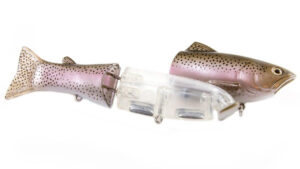
Brown’s tackle suggestions
“Any rod that is fairly heavy and 8 feet long is where you should start,” Brown said. “You’ve got to have a long rod with a lot of power to handle a 6-ounce lure, not to mention what will bite it.”
Brown’s typical glide bait setup starts with a G. Loomis 957 power swimbait rod which is typically a 7-foot, 11-inch XH rod capable of handling baits from 2-10 ounces. With that he pairs a Shimano Calcutta 400 B reel with the wider spool.
“I make thousands of casts on a reel and they will go 3-5 years before I even need to put a drop of oil on them,” Brown said.
His line of choice is 20-pound Seaguar AbrazX fluorocarbon line. He has tried everything from monofilament to braid before finally settling in with fluorocarbon.
“I never use anything bigger than 20-pound AbrazX. It lets the bait sink well and it has good sensitivity and less stretch. The monos and co-polymers get stretched out too much by the middle of the day from casting the heavy lures and fighting big bass. The fluoro will last a few weeks without having to change.”
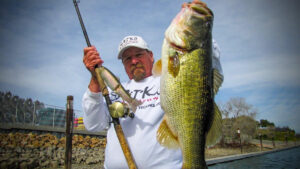
Where to start
Anglers should keep in mind that glide baits are like any other lure in that their presentation must fit the conditions and mood of the fish. And you have to alter your presentation at times just to get a bite. Sure some days you will just throw it out and wind it in and catch bass. But more often than not, when it’s going to work for you, you will know it early in the day.
Brown likes to fish more parallel with glide baits, meaning he will get in close to a channel swing bank or set up on a point where he can throw across the point instead of sitting on the deep end of it and throwing it into the shallowest portion. His Slide Swimmer has tremendous drawing power. So he wants it to be in a zone where the most fish have an opportunity to see and track it.
“On those steeper points, you want to be a little closer to the bank and fish more parallel,” Brown said. “You might cast it out a bit deeper and then bring it back toward shallower water, but you’re still fishing more parallel than perpendicular to the structure.”
Brown works the baits in all depths from the surface down to 20 or more feet. But his comfort zone is 9 to 16 feet in the spring and fall. During the summer months he likes to keep the bait within 6 feet of the surface.
“I can use this bait all year long,” he said. “I can work it uphill or fish it for suspended fish. It’s the only bait that I’ve had in the hot summer months that catches double-digit bass consistently. I will fish it in the hottest part of the day from noon to 2:30. I’ll throw it over deep milfoil or in grass pockets and keep it high.”
Click Here to Watch Butch at Work with the Deps 250!
Retrieves are many
While Brown has caught a lot of 10-pound or heavier bass just slow reeling it and kicking it out and letting it glide, he’s also caught plenty of giants burning, using a stop and go, and crawling it around near the bottom.
But his general retrieve is not with the rod, but rather with the reel.
“It’s not so much in twitching your rod tip,” he said. “You reel it and stall it and then snap it a bit to swing the bait out to one side and let it glide. I use my reel handle say a 1/2 turn or a 1/4 turn at a different speed to give the bait a totally different action.”
You reel slow to moderately slow and focus on feeling the lure. You can tell by your speed if it’s got a wide natural action. Then you start watching for shadows behind and beneath the bait. That’s when you want to give it a little 1/4 turn or a twitch or a pull and make the bait do something different for a second to see if they react.
Some days they will track behind 10 feet and it’s probably not going to happen for you. But those days when you see them tracking like a foot behind it. That’s when you better get ready.
“But those followers are just as important,” he said. “They show me there are fish in the area. I will come back later and try them again, but I use it just as much as a tool to find big fish.”
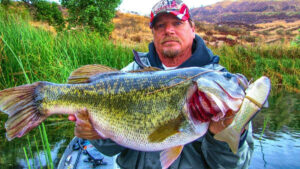
Fight ‘em fast
“You only get a few jumps on the surface with a 6-ounce lure before they get loose,” Brown said.
To combat that Brown takes the approach that he won’t let them turn their head any time in the fight. He keeps them coming to him with the rod low to the water, grinding on the reel and is quick with the net before they start thrashing. That’s again why stout gear is a necessity.
The difference
It’s something they haven’t seen. It’s such a different action that those older wiser bass have not grown accustom to yet. The S-wave of a glide bait is so unique and different and you control it with pauses and reel turns and can give it more drawing power.
“I think anyone that hasn’t tried one, needs to get one and try it for a few days,” Brown said. “I get so many people calling me and sending me notes telling me the Slide Swimmer is the only bait they throw now. One kid in Massachusettes sent me a picture of a bass close to 10 pounds on a glide bait. Now if it’s cold, you’ve still got to put the Hudd in their face, but when they start moving a little more, the glide bait shines.
“As long as you’ve got 2 feet or more of visibility and the drive, you’re going to catch big ones on it. I think it will really open people’s perspective on big bass. It’s got the allure of a Zara Spook or a Lunker Punker, but it looks more like a real fish and it’s down in the water acting like it’s getting chased or pushed along.”
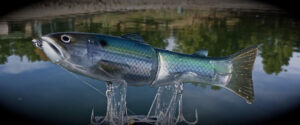
What’s next
Deps Japan and Brown are working to release more color patterns for fishing around the country and around the world. At the 2015 Bassmaster Classic in Greenville, S.C., they will have some of the first Blueback Herring colored Deps Slide Swimmers for purchase but in limited supply.
They recreated the molds for the Slide Swimmer last fall because they were 12 years old. When they did that, they enhanced the materials and the adjustability of the baits as well as their ability to make better ghost patterns. You can read about the updates here.
To see Butch Brown at work with big swimbaits and big bass, visit his Facebook page at Saikobutch Swimbaiter.
And check back later for our next part in this series on glide baits coming after the Classic.
